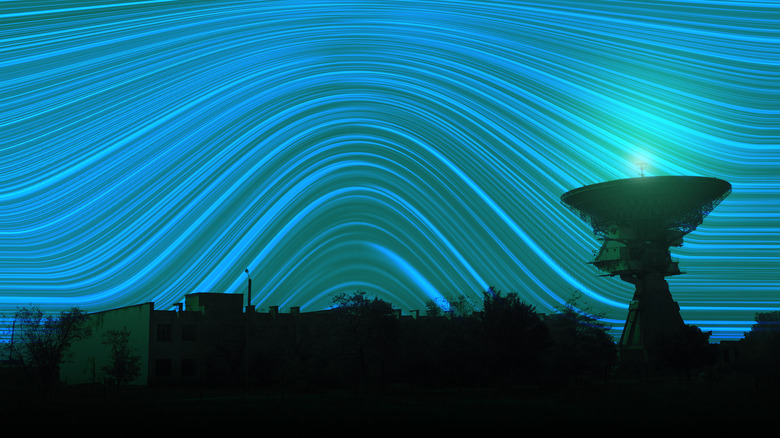China Says They May Have Found Traces Of Alien Life
Chinese authorities claim they may have discovered signs of alien life. This is not the first time a source close to the Chinese Government has said they may have evidence of life on other planets. In 2021, an unverified account allegedly belonging to the Chinese National Space Administration tweeted: "With great ceremony we announce the confirmation of intelligent life!" This, as you'd expect, surprised and confused many people who are trying to figure out what it means. Although the account was not verified, it was followed by other space agencies with verified accounts, including the U.K. Space Agency and U.S. Space Command.
The Galileo Project, which is a Harvard-led attempt by a group of scientists to actively seek out life beyond Earth, also launched the same year. The project uses a combination of research, artificial intelligence, and ground-based telescopes to "known physics to explain newly-observed physical objects." The Galileo Project is not going to comb through previous evidence of alien interaction, but several different agencies are already doing that. In June 2021, the US Government's Office of the Director of National Intelligence announced a task force designed to comb through previous evidence of UFOs.
Largest telescope spots signs of life
The latest claims were made after the "Sky Eye" telescope, which is the largest telescope in the world, spotted "several cases of possible technological traces and extraterrestrial civilizations from outside the Earth." Unlike last year, these recent claims come from an official source and have been reported by China's official Ministry of Science and Technology newspaper. Making the announcement was Professor Zhang Tongjie, chief scientist of the China Extraterrestrial Civilization Research Group at Beijing Normal University.
Professor Tongjie described the discovery as a series of narrow-band electromagnetic signals. Those signals could be from a distant alien civilization, or they could just be radio interference. More research is being conducted to deduce exactly what they are and where they came from.
The Sky Eye telescope was completed in 2016 and opened up to international scientists in 2021. With a diameter of 1600 feet, Sky Eye is larger and three times more sensitive than the telescope at the Arecibo University Observatory which held the largest telescope record for over 50 years. During a 47-day period in 2019, the telescope picked up over 1,600 fast radio bursts — the largest set of fast radio bursts ever recorded. It is theorized that alien civilizations could be a source of these bursts, but as things stand scientists don't know exactly what their origins are.
What is a radio telescope?
People may be familiar with optical telescopes, which allow us to view distant objects by magnifying and focusing the light bouncing off them. Radio telescopes work in a similar way, and can be used to observe far more distant objects. The National Radio Astronomy Observatory (NRAO) defines a radio telescope as an instrument that collects "weak radio light waves, bring it to a focus, amplify it and make it available for analysis." As well as being used to gather "radio light" from objects out in space, the telescopes can also be used to transmit and reflect light off planets within the solar system.
The telescopes are also incredibly sensitive, with the NRAO claiming a standard cell phone signal is "a billion billion times more powerful than the cosmic waves our telescopes detect." That sensitivity has allowed radio telescopes to pick up evidence of objects as far as 13 billion light-years away (via SciTechDaily). The telescopes can also be huge, with the biggest — China's Sky Eye — being 500 meters in diameter. Alternatively, radio telescopes can also be arranged in large arrays.
What is a fast radio burst?
A fast radio burst is a radio wave lasting just a fraction of a second that scientists believe comes from far out in space — though the exact origin of the bursts has not been discovered. They were first discovered in 2007, and have been picked up on massive radio telescopes around the globe. Scientists only recorded a few of the bursts at first, but the Chinese Sky Eye telescope recently started recording hundreds of bursts annually.
Although we have absolutely no evidence that fast radio bursts are the result of alien activity, life in the far-off reaches of space is still cited as a possible origin of the phenomenon. The people suggesting aliens could be responsible for fast radio bursts aren't wrapped in aluminum foil or working as talking heads on the History channel, but rather they're quite accomplished. A Harvard study by professors Manasvi Lingam and Avi Loeb is one of the releases from major institutions that have given weight to the theory. Lingham and Loeb claim a transmitter capable of sending radio signals across the distances fast radio bursts may be traveling would need to be huge and require an immense amount of power — equivalent to the sunlight hitting an area twice the size of Earth. The source, according to Lingham and Loeb, could be the "interstellar light sails" of a space-faring vessel that has a "payload of a million tons."
The pair also theorize the fast radio bursts are incredibly brief because the objects they are coming from are continuously moving, as is the Earth. That movement, coupled with the distance, means Earth and the object transmitting the bursts only line up for a fraction of a second, and that is the part of the wave that hits us.



